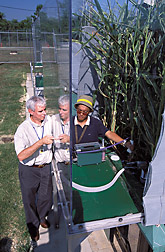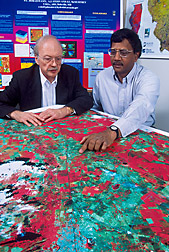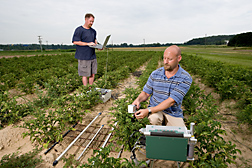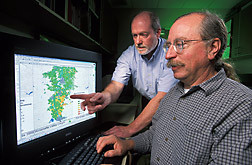Assessing Biofuels’ Sustainability
Economic and Biophysical Models Aid the Process
Over the past decade, the search for alternative fuels has absorbed increasing amounts of agricultural resources, raising questions about how biofuel production affects U.S. agriculture and consumers.
“There are many factors to consider, such as agricultural profitability, environmental impacts, and the trade-offs between using a crop for food or energy,” says Jeff Steiner, leader of the Agricultural Research Service’s national program on Agricultural System Competitiveness and Sustainability (#216). “It is essential that everyone—from the farmer in Iowa to the policymaker in Washington, D.C.—understand the importance of these different elements and work to achieve balance among them.”
Across the United States, ARS scientists are combining economic and natural-resources analyses with data drawn from a national network of field experiments that are being used in models developed by ARS and the USDA Economic Research Service (ERS). Their research is making it easier to understand the consequences of individual and combined management decisions and to predict the most sustainable, economic, and environmentally beneficial courses of action.
Of Models and Maps
One potential energy source is residual biomass—the inedible plant material that remains after harvest. Every year, U.S. farms and forests produce more than 1 billion tons of this material.
“Crop residues are often left in place to help prevent erosion and promote soil health by cycling nutrients and maintaining, or increasing, soil organic matter,” says Marshall C. Lamb, research leader of the National Peanut Research Laboratory in Dawson, Georgia. Removing crop residue can affect those factors.
“Fortunately, these elements can be modeled at the farm level to analyze both the cost of investing in various bioenergy technologies and the changes in agricultural systems required to make the new bioenergy practices sustainable.”
Lamb and his colleagues are collaborating with 21 other ARS locations to examine the sustainability of various production strategies, including growing different energy crops and using crop residues as feedstocks for bioenergy production. They’re using WholeFarm, a model originally designed by ARS scientists to assess crop rotations, commodity prices, yields, and profits. The scientists are updating WholeFarm so that it can gauge the feasibility of using regional crops and residues as sustainable feedstocks that complement existing food, feed, and fiber production systems.
“This information will help us understand the impact of biobased energy technologies on farm income and natural resources quality,” Lamb says.
Models can also help farmers decide which crops are the best to raise for food or bioenergy under their conditions. Growing an unfamiliar crop can be a risky—and costly—decision. But as the demand for biofuels grows, so do incentives to grow bioenergy crops.
In Mandan, North Dakota, ARS agricultural scientist David W. Archer helped develop the Crop Sequence Calculator, a tool that helps producers use their own price and cost information to identify potential economic impacts of crop rotation changes.
Archer has also used field-research information to assess the economic and ecological impacts of specific crop rotations (for example, continuous corn, corn-soybean, and corn-soybean-spring wheat-alfalfa) and tillage systems (conventional tillage or ridge-, strip-, and no-till conservation systems). He is using this information with another ARS model—the Environmental Policy Integrated Climate model (EPIC)—to measure the impact of corn-stover harvest on crop yields and soil organic carbon levels in the Minnesota River watershed.
Corn stover, a crop residue suitable as a biofuel feedstock, helps sequester carbon in the soil. Removing large amounts for bioenergy production could harm the soil and the environment if not managed properly. Archer is using EPIC results to construct a map indicating, for the various soils across the watershed, the lowest possible biomass price that would allow for an economically feasible corn-stover harvest and the impact of biomass harvest on soil carbon levels.
“Profitability is always a main focus, but EPIC also allows us to include risk analysis, that is, the effects of yield and price variability or weather conditions on expected economic returns,” Archer says.
Producers may have opportunities both to increase economic returns and to promote environmental health, he adds. For the benefit of policymakers, EPIC also shows where incentives could encourage producers to pursue environmentally beneficial management practices and still grow biofuel feedstocks.
This is one of many ARS research efforts that could help producers strike a balance between making a profit and promoting healthy soil.
“Because of the expanded use of corn and soybeans for biofuels, there is an economic incentive for farmers to produce more of these commodities,” says V.R. Reddy, research leader of ARS’s Crop Systems and Global Change Research Unit at Beltsville, Maryland.
Reddy and ARS colleagues Dennis Timlin and David Fleisher have developed several models that simulate crop responses to changes in climate and management. GLYCIM, MAIZSIM, and SPUDSIM provide information for soybean, corn, and potato, respectively, when grown as food crops. A fourth model, GOSSYM, is for cotton. The models project biomass volume and crop yields as well as soil water and nitrogen responses. The scientists are updating the models to evaluate the crops’ potential as sustainable biofuel feedstocks and how severe weather, such as drought or climate change, may affect future crop or biofuel feedstock production.
|
|
Environmental Economics
ARS scientists in Texas and Oregon are pairing two ARS biophysical models to evaluate the environmental impact of land-management practices on large, complex watersheds over time. The assessments will also take into account the effects of varying soils, land use, and management conditions.
The CQESTR model simulates changes in soil organic carbon based on factors such as climate, tillage management, crop rotation, and crop residue removal. By incorporating the model into the Soil and Water Assessment Tool—also known as “SWAT”—ARS soil scientist Hero T. Gollany, at Pendleton, Oregon, and agricultural engineer Jeffrey G. Arnold, at Temple, Texas, can predict how land-management practices will influence soil organic carbon, soil organic matter, water, sediment, and agricultural-chemical accumulation.
“Outcomes from the simulations at field and landscape levels will then be used to estimate the amount of crop residue that can be sustainably harvested to maintain soil organic matter,” Gollany says, “and promote harvest of crop residues in a manner that preserves the soil’s capacity to produce food, feed, fiber, and fuel.”
In another project, researchers at ARS’s Hydrology and Remote Sensing Laboratory in Beltsville, Maryland, are studying how certain crops sequester carbon in the soil, which limits its release into the air. Agricultural meteorologist Paul C. Doraiswamy and colleagues investigated how management strategies in the Corn Belt influence the rate of soil carbon sequestration.
“We adapted the EPIC simulation model to predict long-term changes in soil carbon stocks, based on available databases of soils, climate, and farm-management practices,” Doraiswamy says. The model uses variables derived from satellite imagery to map carbon stocks across the Corn Belt.
The simulations assess the long-term effects of practices such as soil tillage and crop-residue management on soil erosion, soil quality, and yield.
“Currently, we’re looking at corn-soybean rotations and continuous-corn cropping systems and evaluating how removal of crop residue affects soil erosion and water quality,” Doraiswamy says. “This research will provide the tools to develop a comprehensive plan for using agricultural resources in the Corn Belt for sustainable production of biofuels.”
Inclusion of economic model results along with estimates from biophysical models will help the scientists forecast the effects of biofuel-feedstock production and harvest at farm, watershed, or regional scales. Profitability is an important consideration, just as factors like water quality and production efficiency are also significant.
Another of the ARS models, PGA-BIOECON, calculates the trade-offs among these three objectives, allowing stakeholders to select the best management decisions to achieve their objectives.
“If a person valued farm profit more than water quality, that person would choose differently than one who valued water quality above all else—but the model would offer the best trade-off for either preference,” says hydrologist Gerald Whittaker, at the Forage, Seed, and Cereal Research Unit in Corvallis, Oregon. “PGA-BIOECON simply provides the best scientific and economic information about those trade-offs, so people can make the best informed choice.”
The Big Picture
This research is part of an interagency effort—in collaboration with ERS, the U.S. Environmental Protection Agency, the U.S. Department of Energy, and USDA’s Natural Resources Conservation Service—to coordinate a multiscale assessment of the economic impact of feedstock production for sustainably producing biofuels.
“Because we’re collaborating on this with other federal agencies, ARS can broaden the scope of our research,” Steiner says. “We want to know how different production options influence not only the field, the farm, and the watershed, but entire regions and the nation as a whole.”
To accomplish this, ERS researchers are making large-scale economic and environmental assessments using their Regional Environment and Agriculture Programming (REAP) model. Drawing on USDA National Agricultural Statistics Service data from the Agricultural Resource Management Survey and ARS’s EPIC, SWAT, and PGA-BIOECON results from field and watershed research, the ERS REAP model can project regional crop acreage, management practices used, and environmental consequences from agricultural activity.
“REAP can account for the effects of crop rotations, production practices, soil types, and geographical characteristics of specific regions,” says ERS economist Scott Malcolm.
The model also allows researchers to assess how the environmental impact of regional farming practices might be affected by policy changes, such as a nitrogen tax or increased ethanol-production incentives. REAP estimates crop-production levels, rotations, and management decisions.
This collaborative research between ARS and ERS is helping their scientists find the best ways to measure the effects of producing and harvesting biofuel feedstocks. This should help farmers, biorefiners, and regulatory and action agencies determine how best to serve the interests of the nation as we pursue ways to reduce our need for petroleum.
“We need food and we need fuel, but those needs shouldn’t be in conflict,” Steiner says. “This coordinated research is illuminating the ways different USDA agencies can work together to serve farm and energy industries—and, of course, consumer interests.”—By Laura McGinnis, Agricultural Research Service Information Staff.
This research is part of Soil Resource Management (#202), Global Change (#204), Water Availability and Watershed Management (#211), Agricultural System Competitiveness and Sustainability (#216), and Bioenergy and Energy Alternatives (#307), five ARS national programs described on the World Wide Web at www.nps.ars.usda.gov.
To reach scientists mentioned in this article, contact Laura McGinnis, USDA-ARS Information Staff, 5601 Sunnyside Ave., Beltsville, MD 20705-5129; phone (301) 504-1654, fax (301) 504-1486.
"Assessing Biofuels’ Sustainability: Economic and Biophysical Models Aid the Process" was published in the October 2008 issue of Agricultural Research magazine.











